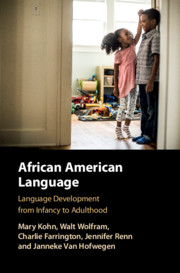Book contents
- African American Language
- African American Language
- Copyright page
- Contents
- Figures
- Tables
- Preface
- Abbreviations
- 1 Coming of Age in African American Language
- 2 The Analysis of Sociolinguistic Change over the Lifespan
- 3 Profiles of Change
- 4 Vowel Variation across Time and Space
- 5 Caretaker’s Influence on Vernacularity
- 6 The Influence of Peers on the Use of African American Language
- 7 Stylistic Variation in the Early AAL Lifespan
- 8 The Relationship of African American Language and Early Literacy Skills
- 9 A Longitudinal Study in Retrospect
- Appendix AAL Feature Code Key
- Index
- References
7 - Stylistic Variation in the Early AAL Lifespan
Published online by Cambridge University Press: 24 November 2020
- African American Language
- African American Language
- Copyright page
- Contents
- Figures
- Tables
- Preface
- Abbreviations
- 1 Coming of Age in African American Language
- 2 The Analysis of Sociolinguistic Change over the Lifespan
- 3 Profiles of Change
- 4 Vowel Variation across Time and Space
- 5 Caretaker’s Influence on Vernacularity
- 6 The Influence of Peers on the Use of African American Language
- 7 Stylistic Variation in the Early AAL Lifespan
- 8 The Relationship of African American Language and Early Literacy Skills
- 9 A Longitudinal Study in Retrospect
- Appendix AAL Feature Code Key
- Index
- References
Summary
In this chapter, we consider stylistic shifting at several different temporal points, Grades 1/2, Grade 6, and Grade 8. Utilizing different strategies for eliciting formal and informal speech (presenting a planned speech for a parent audience vs. having lunch with a peer), we then compare the DDM scores in the two activities, using both a difference score and a ratio score to determine the shift between styles at the three temporal datapoints. Three main trajectories of shifting behavior take place during elementary and middle school. First, some speakers exhibit a general increase over time, indicating that speakers are engaging in more and more shifting as they age. Second, there is also an inverted V pattern, which shows that by Grade 6, shifting ability has increased, but in Grade 8 they are shifting less. Since these speakers are engaging in shifting behavior in Grade 6, it seems unlikely that they lose the ability to shift in Grade 8; instead, perhaps other outside factors may be influencing their linguistic behavior. The results suggest that the speakers have developed an increased ability to shift their language in response to contextual differences by the time they reach middle school. Age clearly plays an important role, with speakers shifting more as they get older, but gender also proves to be a relevant motivator for style shift.
Keywords
- Type
- Chapter
- Information
- African American LanguageLanguage development from Infancy to Adulthood, pp. 167 - 190Publisher: Cambridge University PressPrint publication year: 2020



